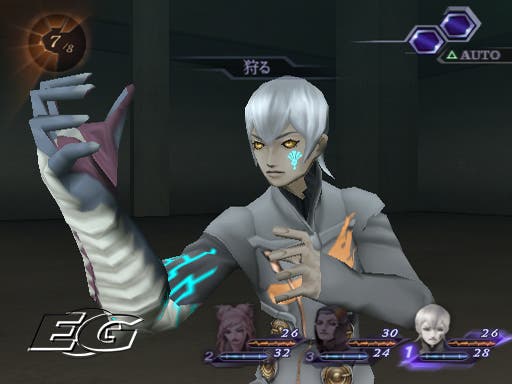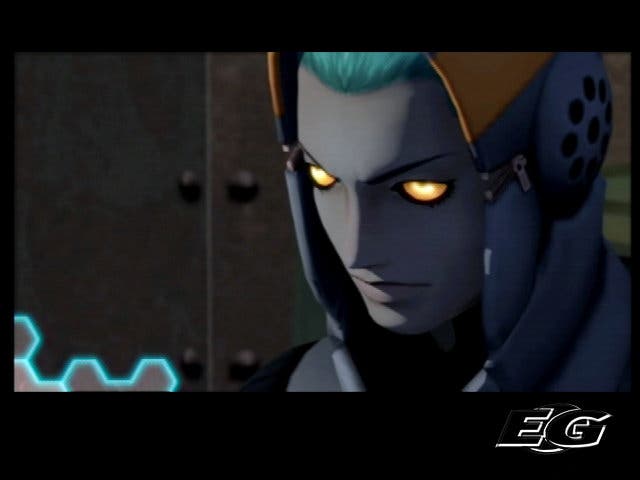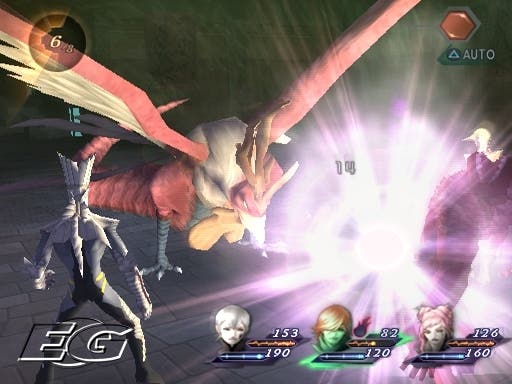Shin Megami Tensei: Digital Devil Saga 2
See you in hell.
Atlus; I'm sorry. I said some things I didn't mean, and I'm sorry.
When I was reviewing the original Digital Devil Saga - which I liked, remember? Remember how we smiled at each other when Eurogamer awarded it 8/10? - I said that people wanting to play a game with good storytelling should look elsewhere. Look, I was angry; I thought you were being obtuse when you made me play through pretty long and, let's be honest, somewhat barren dungeon sections just to get to the next morsel of storytelling. I didn't mean to say that you weren't spinning a good yarn, just that maybe you could have spun it a bit faster. In hindsight, that was cruel and uncalled for. I shouldn't have said it. I can admit my mistakes; I'm sorry.
You see, now that I've played the next chapter in the saga, my eyes have been opened. I've seen what you were trying to say all along, and I've seen the destination at the end of the occasionally bumpy road. Don't walk away from me now. We can work this out together. I love you.
The Devil's Own
And that, dear readers, is the truth of the matter. There comes a point where you have to throw your hands up and admit that you made a mistake, and accusing Digital Devil Saga of weak storytelling was mine. It's a mistake I'd entirely forgotten about until I dredged up my review after playing through to the stunning conclusion of the second part, Digital Devil Saga 2, and gawped in horror at my own wrongness. In my defence, Digital Devil Saga did string its storyline out thinly over a heavily dungeon-focused and lengthy play experience - and it's clear from some changes to DDS2 that the development team recognised this as a flaw of the original - but that shouldn't have detracted from the fact that the game boasted mature, interesting and extraordinarily complex characters, a deliciously twisted morality, a taste for darkness and an undercurrent of horror which sets it apart from the vast bulk of other videogames.

The story of the first Digital Devil Saga, uniquely for a game which was clearly conceived as the first half of a wider tale, did actually have a satisfying conclusion - which I won't spoil here, since many of you have probably never played the game. However, not all of the game's mysteries, nor its characters, reached closure; and Digital Devil Saga 2, which continues on directly from the end of the first game, picks up the story and rapidly spins it into a beautifully realised epic which makes the original game feel like a mere prologue.
Powerful storytelling and characterisation which has its roots in the first part of the series is given a chance to blossom fully in DDS2, as the action shifts from the rain-soaked Junkyard of DDS to a new and disquieting world, an alternate Earth in which the merest touch of the rays of a black sun can turn humans into stone statues, and only those bonded to powerful demons can roam the surface with impunity. The bleak, oppressive atmosphere of the first game remains, and while several fascinating new characters are introduced, the emphasis remains on exploring the fascinating personalities who have been the stars from the outset - including Serph, arguably one of the most complex and well-realised anti-heroes the videogame medium has yet created, a character so strangely pitched that you often find yourself wondering if you're actually playing the villain of this tale. It's a refreshing change from spiky-haired amnesia-stricken do-gooders, that's for sure.
All Satan's Parties

Not only is the storyline of DDS2 a wonderful and perfectly pitched continuation of DDS' narrative, it's also learned from the failings of its predecessor - and is a much better paced game as a result. Dungeon exploration remains the mainstay of the game, but this time the team have liberally peppered plot and character advancement throughout the various dungeons, rather than simply using it to bookend the various intensive gameplay sections. Not only does this mean that the dungeons provide far more frequent rewards in terms of story advancement, it also means that when you do emerge, the exposition sections are altogether more brief and well-paced than in the first game. Overall, the game clocks in at around the same length as the original DDS (ranging anywhere up to the 40-odd hour mark if you do a fair bit of optional content, but undoubtedly much shorter if you just rip through the central storyline) but it feels like a far richer experience due to the more consistent use of narrative.
The pacing of the game isn't the only lesson which DDS2 has learned from the original game - it has also dropped the encounter rate, so battles are somewhat less common, albeit still a more frequent sight than in rather a lot of other, more forgiving JRPGs. However, quick loading times for the battle system make this more forgiveable than previously - and as in the original DDS, the battle system itself is intriguing, challenging, and quite a lot of fun. Little has changed in the battle system itself (although the levelling and ability system has been altered significantly, moving away from the Sphere Grid layout of DDS and into a much more configurable grid system not entirely unlike FFXII's License Board), and attacking and defending using the appropriate elements remains key to your success in the game - with failure to defend appropriately often costing you dearly, as you lose the initative in battle, while attacking in the most effective way can see you finishing even difficult battles without a scratch.

A few new twists do keep things interesting. For a start, there's a randomly triggered Berserk mode, in which your characters start the battle in half-demon form, which requires a major change in tactics; there's also a whole new layer of complexities using ring-like accessories, into which various gems you find around the world can be fitted to trigger various boosts or effects. The aforementioned license board style layout for the ability system also changes your approach to the game, since it means that characters no longer progress through learning the abilities in a pre-defined, linear manner - instead you can largely choose to build your characters as you please, specialising them in a variety of key areas and customising them to your own battle style.
The dungeon layouts, too, are a bit more user-friendly - many save points allow you to teleport around, which saves a lot of unnessecary tedium, while along with the lower encounter rate, there are also shops located in quite a few dungeons. All in all, it makes for a game which is a genuinely excellent evolution of its predecessor - while DDS was a great game in its own right, the sequel effectively smooths over the rough surfaces and knocks off the sharp edges, making for an experience which is genuinely a pleasure to play for veterans of the first title. Those who didn't play the original DDS are, of course, recommended to start off there - but if you do want to start into DDS2 without playing the original, while there's quite a bit of narrative catching up to do, the game experience is certainly excellent and does a fine job of introducing new players to the battle system without patronising or boring the existing audience.
A Man of Wealth and Taste

In terms of presentation, Atlus have done the excellent job you'd expect on the strength of the recent Shin Megami Tensei output (SMT being the overall franchise of which the Digital Devil Saga games are a part - although the links between them are thematic more than anything else, so there's no direct storyline correlation between this game and other Shin Megami Tensei titles such as Lucifer's Call). The artwork maintains the beautiful, flat-shaded minimalism which lends the whole game a stark and memorable look, with visuals reminiscent of many of the better recent attempts at dragging Japanese anime out of the giant robots / schoolgirl harems cliche factory. The music, meanwhile, is downright excellent - a compelling and often surprising mish-mash of styles ranging from rock and choral chants to pop tracks, linked by several common themes which resonate throughout the entire soundtrack. It's definitely a step up from the soundtrack to the first Digital Devil Saga, and better even than the superb audio which accompanied Lucifer's Call. Also worthy of note is the voice acting; perhaps it's that the actors are more settled with their roles in this second outing, but almost every line in the game was perfectly decent, which is rare praise for an overdubbed title.
Digital Devil Saga 2 is everything that an excellent sequel should be. It takes on board criticisms levelled at the former game and addresses them all in a way which should delight any fan of the series; not only that, it picks up the story and characters of the original title and develops them in such a fascinating way that it actually throws fresh light on the original, which now seems like a much better piece of storytelling in the context of its part in the series as a whole. We've seen plenty of sequels which mar the memory of the original game, but one which actually makes the original game seem even better? That's a rare beast indeed. There may be plenty more fish in the sea, but when I said "I love you", I meant it. The joy of videogames, of course, is that I'm more than happy for everyone else to love the DDS series too - and I promise not to wave a pint glass in a threatening manner and inquire as to whether you're eyeing up my game.

